We love tomboys. Girls who wear boys clothing and engage in soccer games and all kind of other physical activities that are considered in many cultures to be unfeminine or the domain of boys. There were many stars who liked yo do a bit of gender bender, think Marlene Dietrich, Greta Garbo, Katherine Hepburn. But earlier in the European cinema of the 1920s 'trouser' roles were even a trend. Today a salute to these revolutionary girls who weren't scared to act like boys.
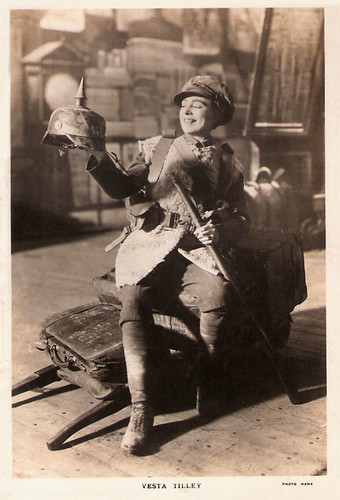
British postcard in the Real Photo series. Photo: Hana.
English actress Vesta Tilley (1864–1952) was the most famous and well paid music hall male impersonator of her day, nicknamed ‘The London Idol’. She was a star in both Britain and the United States for over thirty years. Tilley also appeared in some very early silent films.
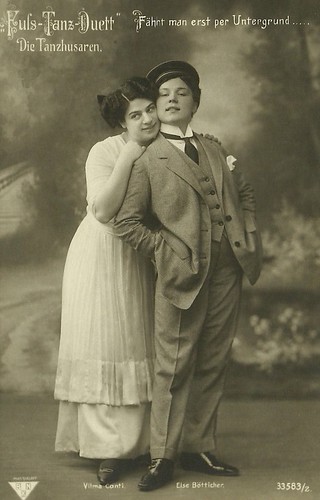
Else Bötticher (right) and Vilma Conti. German postcard by BNK, no. 33 583/2. Caption: "Fuss-Tanz-Duett. Fährt man erst per Untergrund.... Die Tanzhusaren." Collection: Didier Hanson.
In the early 20th century, German actress Else Bötticher (1880-1966) performed with famous stage stars in international theatres. During the 1910s, she made several silent films. In the sound era, she returned to the cinema but then only played small roles as wives and mothers.

Romanian postcard. Photo: Atelier Kossak, Timisoara. Collection: Didier Hanson.
It's difficult to find any information about this comic lady in drag, Anny Hochwald. Was she an Austrian or German cabaret performer of the early 20th Century, as her name and outfit suggest?

German postcard by Ross Verlag, Berlin, no. 644/3. Photo: Art-Films. Publicity still for Hamlet (Svend Gade, Heinz Schall, 1921), starring Asta Nielsen as Hamlet. Nielsen had produced the film herself. Collection: Didier Hanson.
Danish silent film actress Asta Nielsen (1881-1972), was one of the most popular leading ladies of the 1910s and one of the first international film stars. Of her 74 films between 1910 and 1932, seventy were made in Germany where she was known simply as Die Asta. Noted for her large dark eyes, mask-like face and boyish figure, Nielsen most often portrayed strong-willed passionate women trapped by tragic consequences.
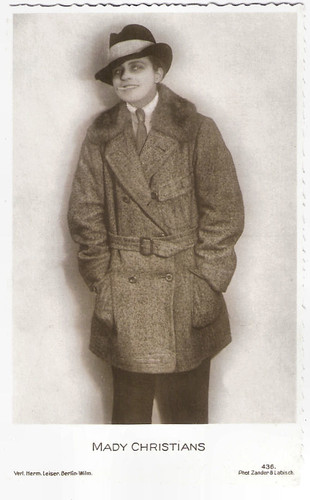
German postcard by Verlag Hermann Leiser, Berlin-Wilm., no. 436. Photo: Zander & Labisch.
Austrian-born stage actress Mady Christians (1892-1951) was a star of the German silent cinema and appeared in Austrian, French, British and Hollywood films too.

German postcard by Ross Verlag, no. 1485/4, 1927-1928. Photo: Atelier Balázs, Berlin.
Lya Mara (1897-1960?) was one of the biggest stars of the German silent cinema. Her stardom was even the subject of a novel, which was published in 100 episodes between 1927 and 1928. Her career virtually ended after the arrival of sound film.

German postcard by Ross Verlag, no. 3228/3, 1928-1929. Photo: M. von Becovich (Atelier K. Schenker).
The profoundly sensitive acting of Austrian-British actress Elisabeth Bergner (1897-1986) influenced the German cinema of the 1920s and 1930s. She specialised in a bisexual type that she portrayed in Der Geiger von Florenz and in other film and stage roles. Nazism forced her to go in exile, but she worked successfully in the West End and on Broadway.
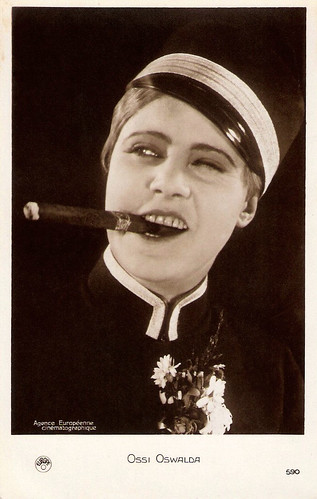
French postcard in the Europe series, no. 590. Photo: Agence Européenne Cinematographique.
Ossi Oswalda (1895-1947) was one of the most popular comediennes of the German silent cinema.
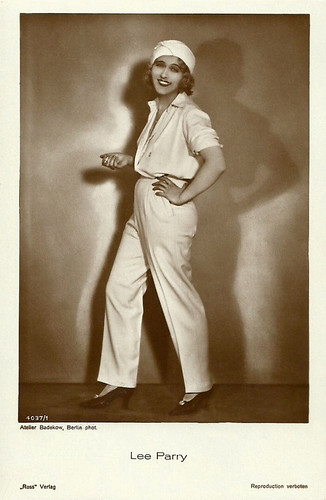
German postcard by Ross Verlag, no. 4037/1, 1929-1930. Photo: Atelier Badelkow, Berlin.
Lee Parry (1901-1977) was a German film actress of the silent and the early sound era, often in films by her husband Richard Eichberg. She appeared in 48 films between 1919 and 1939.
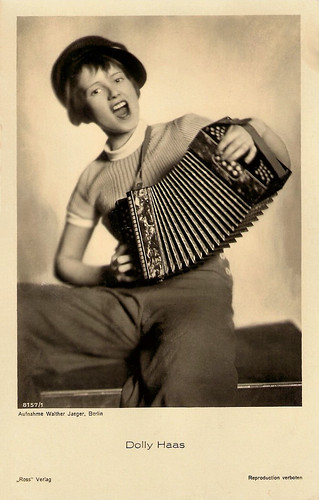
German postcard by Ross Verlag, no. 8157/1, 1933-1934. Photo: Walther Jaeger, Berlin.
Stage and screen actress Dolly Haas (1910-1994) was popular in the 1930s as a vivacious, red-haired gamine often wearing trousers in German and British films.
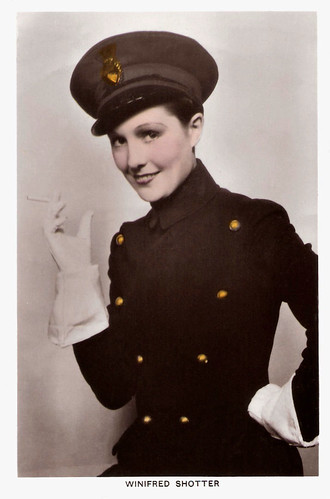
British postcard in the Colourgraph Series, London, no. C 146.
British film actress Winifred Shotter (1904–1996) was the pretty young thing in a number of the popular Aldwych farces, which were staged in London before and during the Second World War. During the 1930s, she also performed in early British films with great success.
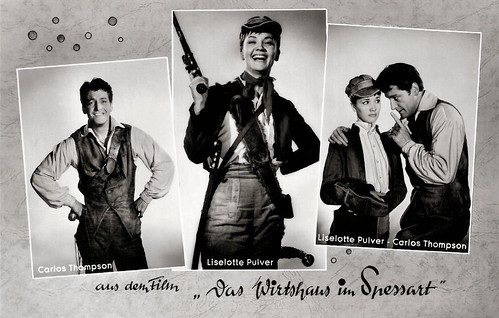
German postcard by Franz Josef Rüdel, Filmpostkartenverlag, Hamburg-Bergedorf, no. 2374. Photo: Witt / Constantin / Ringpress / Vogelmann. Publicity card for Das Wirtshaus im Spessart/The Spessart Inn (Kurt Hoffmann, 1958) with Liselotte Pulver and Carlos Thompson.
Swiss actress Liselotte Pulver (1929) was one of the most beloved stars of the German popular cinema of the 1950s and early 1960s. Despite a wide variety of roles, she is best remembered as the merry tomboy in sparkling comedies like Das Wirtshaus im Spessart/The Spessart Inn (1958).
Source: Laura Horak (Girls Will Be Boys) and Wikipedia.
This is a post for Postcard Friendship Friday, hosted by Beth at the The Best Hearts are Crunchy. You can visit her by clicking on the button below.


British postcard in the Real Photo series. Photo: Hana.
English actress Vesta Tilley (1864–1952) was the most famous and well paid music hall male impersonator of her day, nicknamed ‘The London Idol’. She was a star in both Britain and the United States for over thirty years. Tilley also appeared in some very early silent films.

Else Bötticher (right) and Vilma Conti. German postcard by BNK, no. 33 583/2. Caption: "Fuss-Tanz-Duett. Fährt man erst per Untergrund.... Die Tanzhusaren." Collection: Didier Hanson.
In the early 20th century, German actress Else Bötticher (1880-1966) performed with famous stage stars in international theatres. During the 1910s, she made several silent films. In the sound era, she returned to the cinema but then only played small roles as wives and mothers.

Romanian postcard. Photo: Atelier Kossak, Timisoara. Collection: Didier Hanson.
It's difficult to find any information about this comic lady in drag, Anny Hochwald. Was she an Austrian or German cabaret performer of the early 20th Century, as her name and outfit suggest?

German postcard by Ross Verlag, Berlin, no. 644/3. Photo: Art-Films. Publicity still for Hamlet (Svend Gade, Heinz Schall, 1921), starring Asta Nielsen as Hamlet. Nielsen had produced the film herself. Collection: Didier Hanson.
Danish silent film actress Asta Nielsen (1881-1972), was one of the most popular leading ladies of the 1910s and one of the first international film stars. Of her 74 films between 1910 and 1932, seventy were made in Germany where she was known simply as Die Asta. Noted for her large dark eyes, mask-like face and boyish figure, Nielsen most often portrayed strong-willed passionate women trapped by tragic consequences.

German postcard by Verlag Hermann Leiser, Berlin-Wilm., no. 436. Photo: Zander & Labisch.
Austrian-born stage actress Mady Christians (1892-1951) was a star of the German silent cinema and appeared in Austrian, French, British and Hollywood films too.

German postcard by Ross Verlag, no. 1485/4, 1927-1928. Photo: Atelier Balázs, Berlin.
Lya Mara (1897-1960?) was one of the biggest stars of the German silent cinema. Her stardom was even the subject of a novel, which was published in 100 episodes between 1927 and 1928. Her career virtually ended after the arrival of sound film.

German postcard by Ross Verlag, no. 3228/3, 1928-1929. Photo: M. von Becovich (Atelier K. Schenker).
The profoundly sensitive acting of Austrian-British actress Elisabeth Bergner (1897-1986) influenced the German cinema of the 1920s and 1930s. She specialised in a bisexual type that she portrayed in Der Geiger von Florenz and in other film and stage roles. Nazism forced her to go in exile, but she worked successfully in the West End and on Broadway.

French postcard in the Europe series, no. 590. Photo: Agence Européenne Cinematographique.
Ossi Oswalda (1895-1947) was one of the most popular comediennes of the German silent cinema.

German postcard by Ross Verlag, no. 4037/1, 1929-1930. Photo: Atelier Badelkow, Berlin.
Lee Parry (1901-1977) was a German film actress of the silent and the early sound era, often in films by her husband Richard Eichberg. She appeared in 48 films between 1919 and 1939.

German postcard by Ross Verlag, no. 8157/1, 1933-1934. Photo: Walther Jaeger, Berlin.
Stage and screen actress Dolly Haas (1910-1994) was popular in the 1930s as a vivacious, red-haired gamine often wearing trousers in German and British films.

British postcard in the Colourgraph Series, London, no. C 146.
British film actress Winifred Shotter (1904–1996) was the pretty young thing in a number of the popular Aldwych farces, which were staged in London before and during the Second World War. During the 1930s, she also performed in early British films with great success.

German postcard by Franz Josef Rüdel, Filmpostkartenverlag, Hamburg-Bergedorf, no. 2374. Photo: Witt / Constantin / Ringpress / Vogelmann. Publicity card for Das Wirtshaus im Spessart/The Spessart Inn (Kurt Hoffmann, 1958) with Liselotte Pulver and Carlos Thompson.
Swiss actress Liselotte Pulver (1929) was one of the most beloved stars of the German popular cinema of the 1950s and early 1960s. Despite a wide variety of roles, she is best remembered as the merry tomboy in sparkling comedies like Das Wirtshaus im Spessart/The Spessart Inn (1958).
Source: Laura Horak (Girls Will Be Boys) and Wikipedia.
This is a post for Postcard Friendship Friday, hosted by Beth at the The Best Hearts are Crunchy. You can visit her by clicking on the button below.

What a wonderful collection of Girls will be boys!!! There were quite a lot of them. Thanks for sharing!
ReplyDeleteHow absolutely wonderful! I absolutely love these mischievous young ladies! Thank you for sharing. I look forward to see what you will post every single week! Have a lovely weekend, my Friend.
ReplyDelete